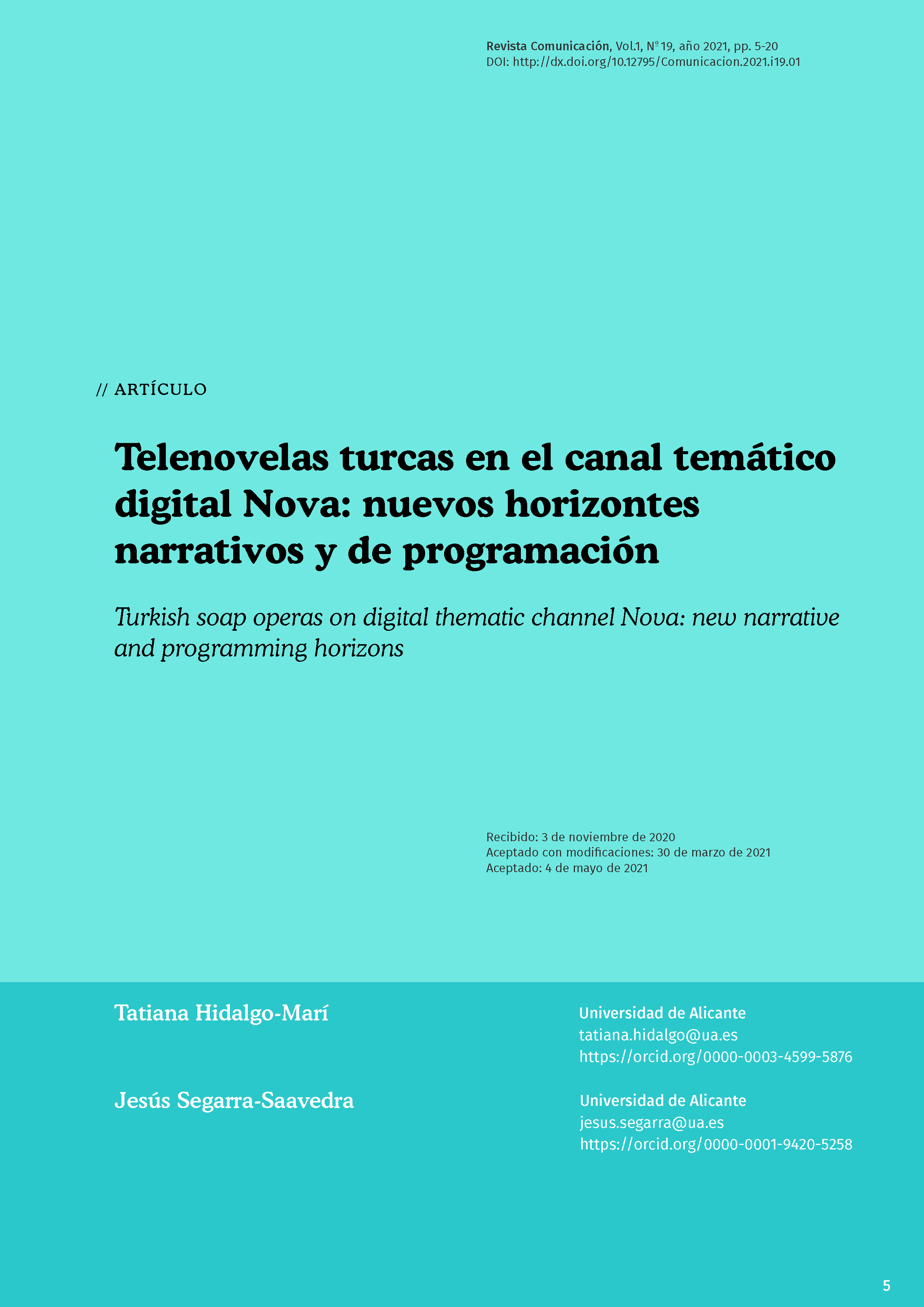Abstract
This paper aims to provide a taxonomy on the Turkish soap opera issued on the Spanish thematic channel Nova, in order to determine new strategies and narratives in trend. For this, a qualitative methodology is combined with the discourse analysis that offers results on the differences and similarities between the Turkish and Latin American soap opera and allows trends that are contributing to the positioning of the narrative product in question.
References
ABU-LUGHOD, Lila (2002): “Egyptian Melodrama: Technology of the Modern”, en Media worlds: Anthropology on new terrain, nº 21, pp. 75-102. doi: http://dx.doi.org/10.1590/S0104-83332003000200005
ACOSTA-ALRUZU, Carolina (2003): “I am Not a Feminist… I Only Defend Women as Human Beings: The Production, Representation, Consumption of Feminism in a Telenovela”, en Critical Studies in Media Communication, nº 20(3), pp. 269-249. doi: https://doi.org/10.1080/07393180302775
AKIN, Altug (2009): “Dirty Seeds of Media Transformation in Turkey: The Vertigo of Communication, the Young Party (Genc Parti) and the Democratic Deficit”, en Eastbound (2). Recuperado de http://eastbound.eu/2010/akin
AKIN, Altug (2011): “Cuando se abre la caja mágica de Pandora. Desarrollo de los medios en Turquía”, en Infoamérica: Iberoamerican Communication Review, nº 6,pp. 97-114. Recuperado de https://bit.ly/2BVe5bh
AVENDAÑO, Tom C. (2019): “Las telenovelas turcas conquistan España”, en El País, 22 de febrero. Recuperado de https://bit.ly/2KLefqw
BALLI, Faruk, BALLI, Hatice O. & CEBECI, Kemal (2013): “Impacts of exported Turkish soap operas and visa-free entry on inbound tourism to Turkey”, en Tourism Management, nº 37, pp. 186-192. doi: https://doi.org/10.1016/j.tourman.2013.01.013
BARLOVENTO COMUNICACIÓN (2019): “Análisis televisivo 2018”. Recuperado de https://bit.ly/2NqVEAD
CABRUJAS, José Ignacio (2002): Y Latinoamérica inventó la telenovela. Caracas: Alfadil Ediciones.
CAMILLE FERREIRA, Gabrielle (2018): “O resgate do melodrama: uma análise do interesse das telespectadoras brasileiras”, en Congreso COMUNICON 6º Simposio Internacional. Recuperado de https://bit.ly/32NmVTC
CETIN, Emre (2014): “The “Politicization” of Turkish Television Dramas”, en International Journal of Communication, nº 8, pp. 2462-2483. Recuperado de https://bit.ly/36iaDFK
CHICHARRO-MERAYO, María del Mar (2011): “Historia de la telenovela en España: aprendizaje, ensayo y apropiación de un género”, en Comunicación y Sociedad, nº 24(1), pp. 189-216. Recuperado de https://bit.ly/2N24tlG
CUEVA, Álvaro (1999): Lágrimas de cocodrilo: historia mínima de las telenovelas en México. México: Tres Lunas.
DELOITTE (2014): “World’s most colorful screen. TV series sector in Turkey”. Recuperado de https://bit.ly/2JAOpFi
FIGARO, Roseli A. (1997): “La telenovela brasileña en el mercado internacional”, en Estudios sobre las Culturas Contemporáneas, nº3(6), pp. 33-47.
GALLARDO, Francisco A. (2019): “Turquía se ha reencontrado con la esencia de las telenovelas”, en Diario de Sevilla, 10 de febrero. Recuperado de https://bit.ly/2Wut5GK
GONZÁLEZ-RUBÍN, Beatriz (2007): “La telenovela como fenómeno social”, en Congreso Latinoamericano de Investigadores de la Comunicación (Monterrey). Recuperado de: https://goo.gl/Cj8uso
HIDALGO-MARÍ, Tatiana (2011). El castigo de la mujer antagonista en las telenovelas: estandarización y conservadurismo en el desenlace fatal. En Mateos-Martín, C., Ardèvol-Abreu, A. y Toledano-Buendía, S. (Coords.), La comunicación pública, secuestrada por el mercado (p. 33). La Laguna: Sociedad Latina de Comunicación Social.
HIDALGO-MARÍ, T. (2018). La comedia familiar española desde la apertura del mercado televisivo hasta el apagón analógico: Formatos, audiencias y producción (1990-2010). Comunicación y Sociedad, 31(2), 39-50. doi: https://doi.org/10.15581/003.31.2.39-50
HIDALGO-MARÍ, Tatiana; TOUS-ROVIROSA, Anna. & MORALES-MORANTE, Luís. F. (2019): “Los modelos familiares en la comedia televisiva española (1990-2010)”, en Revista Latina de Comunicación Social, nº 74, pp. 1-11. doi: https://doi.org/10.4185/RLCS-2019-1318
HUDSON, Leila (2014): “Neopatriarchy in Syrian and Turkish Television Drama: Between the Culture Industry and the Dialect Imagination”. en Media Evolution on the Eve of the Arab Spring (pp. 127-138). Palgrave Macmillan, New York.
KHARROUB, Tamara & WEAVER, Andrew. J. (2014): “Portrayals of women in transnational Arab television drama series”, en Journal of Broadcasting & Electronic Media, nº 58(2), pp. 179-195. doi: https://doi.org/10.1080/08838151.2014.906434
LACALLE, Charo & GÓMEZ, Beatriz (2016): “The representation of workingwomen in Spanish television fiction”, en Comunicar, nº 24(47), pp. 59-67. doi: https://dx.doi.org/10.3916/C47-2016-06
LACALLE, Charo y HIDALGO-MARÍ, Tatiana (2016): “La evolución de la familia en la ficción televisiva española” en Revista Latina de Comunicación Social, nº 71, pp. 470-483. doi: https://doi.org/10.4185/RLCS-2016-1105
LATABAN, Ant (1995): Consumo de telenovelas por estudiantes de universidades privadas. Mexico Puebla: Universidad de las Américas Puebla.
MARTÍN-BARBERO, Jesús (1992): Televisión y Melodrama. Bogotá: Tercer Mundo Editores.
MAZZIOTI, Nora (1996): La industria de la telenovela. La producción de ficción en América Latina. Barcelona: Paidós
MOLINA, Lucía (2013): “El papel de la ficción televisiva en la situación sociolingüística del árabe”, en RAEL: revista electrónica de lingüística aplicada, nº 12, pp. 101-110. Recuperado de https://bit.ly/2Pv1OT7
MORALES-MORANTE, Luís F. (2008): “Telenovela latinoamericana en España: Identidades culturales y confluencias comerciales”, en Chasqui. Revista Latinoamericana de Comunicación, nº 104, pp. 52-59. Recuperado de https://bit.ly/31Xd4dn
OROZCO GÓMEZ, Guillermo (2006): “La telenovela en México: ¿de una expresión cultural a un simple producto para la mercadotecnia?”, en Comunicación y Sociedad, nº 6, pp. 11-35. https://bit.ly/2X9EI68
OZALPMAN, Deniz (2017): “Transnational Viewers of Turkish Television Drama Series”, en Transnational Marketing Journal, nº 5(1), pp. 25-43. doi: https://doi.org/10.33182/tmj.v5i1.386
OZBEK, Meral (1991): Popüler Kültür ve Orhan Gencebay Arabeski. Estambul: Iletisim.
OZMEN, Seckin (2011): “Global Culture And The Representation Of Otherhood In A Popular Turkish Television Drama”, en International Journal of Arts & Sciences, nº 4(24), pp. 143. Recuperado de https://bit.ly/2qFaoED
QUISPE AGNOLI, Rocío. (2009): “La telenovela latinoamericana frente a la globalización: Roles genéricos, estereotipos y mercado”, en Revista Académica La Mirada de Telemo, nº 2. Recuperado de https://bit.ly/2XE29oF
STOKES, Martin (1992): The Arabesk Debate: Music and Musicians in Modern Turkey. Oxford: Clarendon Press.

This work is licensed under a Creative Commons Attribution-NonCommercial-ShareAlike 4.0 International License.
Copyright (c) 2022 Tatiana Hidalgo María y Jesús Segarra-Saavedra

